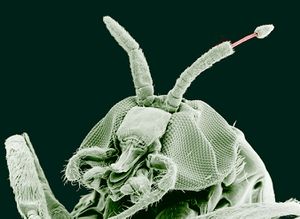Nematocera
Lua error in package.lua at line 80: module 'strict' not found.
| Nematocera | |
|---|---|
 |
|
| SEM image of Simulium yahense, a black fly | |
| Scientific classification |
|
| Kingdom: | Animalia |
| Phylum: | Arthropoda |
| Class: | Insecta |
| Order: | Diptera |
| Suborder: | Nematocera |
| Infraorders | |
|
Axymyiomorpha |
|
Lua error in Module:Taxonbar/candidate at line 22: attempt to index field 'wikibase' (a nil value).
The Nematocera (thread-horns) are a suborder of elongated flies with thin, segmented antennae and mostly aquatic larvae, consisting of the mosquitoes, crane flies, gnats, black flies, and midges.
Nematocera are typically characterized by filamentous, multisegmented antennae which may be plumose in some males. The Nematocera are a paraphyletic suborder, because one of its constituent families (Anisopodidae) is apparently a sister taxon to the entire suborder Brachycera; an alternative classification has been proposed in which the family Nymphomyiidae (traditionally classified within the Blephariceromorpha) is removed to its own suborder, the Archidiptera, and all the remaining nematoceran families are placed in a suborder called Eudiptera; however, the Eudiptera are also paraphyletic, and this classification has not been widely accepted. Largely due to its long history, the name Nematocera continues to be used.
Examples of the Nematocera include the mosquitoes (Culicidae), crane flies (Tipulidae) and black flies (Simuliidae). Many of the remaining families (especially Mycetophilidae, Anisopodidae, and Sciaridae), are called gnats, while others (especially Chironomidae, Cecidomyiidae, and Ceratopogonidae) are called midges.
The larvae are mostly aquatic and have distinct heads with mouthparts that may be modified for filter feeding. The pupae are orthorrhaphous (meaning adults emerge from the pupa through a straight seam in the pupal cuticle). The bodies and legs of the adults are usually elongate, and these flies often have relatively long abdomens.
Many species form mating swarms of males, and in some of these, competition for females is extreme. Although many species (as larvae) have a strong association with water, even within a single family there may be a trend toward semiaquatic and terrestrial habitats.
Families
- Anisopodidae – wood gnats or window-gnats
- Axymyiidae -
- Bibionidae – march flies and love bugs
- Blephariceridae – net-winged midges
- Bolitophilidae -
- Canthyloscelididae -
- Cecidomyiidae – gall midges or gall gnats
- Ceratopogonidae – biting midges
- Chaoboridae – phantom midges
- Chironomidae – chironomids or nonbiting midges
- Corethrellidae -
- Culicidae – mosquitoes
- Deuterophlebiidae –
- Diadocidiidae –
- Ditomyiidae –
- Dixidae –
- Hesperinidae –
- Keroplatidae –
- Lygistorrhinidae -
- Mycetophilidae – fungus gnats
- Nymphomyiidae -
- Pachyneuridae -
- Pediciidae -
- Perissommatidae -
- Psychodidae – moth flies or drain flies
- Ptychopteridae – phantom crane flies
- Rangomaramidae -
- Scatopsidae – minute black scavenger flies or dung midges
- Sciaridae – dark-winged fungus gnats
- Simuliidae – black flies
- Tanyderidae -
- Thaumaleidae -
- Tipulidae – crane flies
- Trichoceridae – winter crane flies